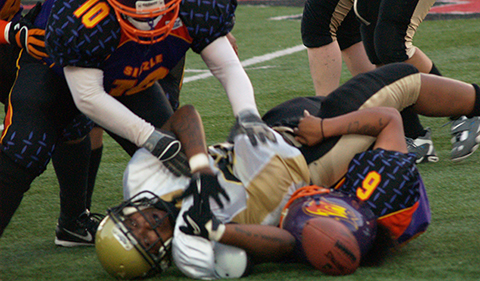
The Cincinnati Sizzle vs. the Pittsburgh Force in 2012. Photo by J.A. Carter family.
By Abigail Stephens ’17 and Nikki Rodriguez ’16
Dr. J.A. Carter visited a sociology class at Ohio University this spring to discuss constructions and practices of female masculinity, particularly in women’s football.
Carter, a professor at Miami University in Sociology and Gerontology, studies gender, sexuality and the body, particularly in relation to sports and the media.
She spent two years conducting participant observation research for her dissertation while playing full-contact tackle football on a women’s football team (the Cincinnati Sizzle) in Cincinnati, and she discussed the experiences and findings of this research with Kelli Chapman’s Sociology of Masculinity (SOC 3720) class. The Sizzle competes in the U.S. Women’s Football League.
“I played for two seasons as largely a cornerback,” Carter said. “I played every position except for quarterback at some point.
“In general, when we think of football, we think of men,” Carter said. “Today we’re going to question the idea that only men play football because that’s a huge misconception.”
She brought up a slide depicting a group of football players in a huddle. “I’ve used this in my intro classes every semester. I ask them what’s happening in this picture and the meanings we attach to [it] … and not one single class has identified these people as women. Our assumption is that ‘if people are playing football, they have to be men.’”
When Carter revealed that she is one of the players in the picture, she got a big reaction. This allows her to open up a dialogue about what masculinity really is.
“Masculinity is not just things men do, but in the general sense that’s often how we define it,” she explained. “That’s a really problematic definition, because we know that female bodies engage in masculinity.”
She also encouraged the class to question popular associations between masculinity and athletic ability by demonstrating the rough and intense nature of women’s football through personal anecdotes, pictures, and videos.
‘I had no idea it was that intense!’

Carter played a video collage from the Lingerie Football League, a women’s football division that plays full-contact tackle football in startlingly low-coverage uniforms. The video was an amalgamation of violent tackles between female football players, many of whom were quite muscular and engaged in expletive language after their successful performances.
In response to the video, one student commented, mouth agape, “I had no idea it was that intense.”
Carter also engaged the class in a throwing activity designed to question the validity of the popular taunt, “You throw like a girl!”
She asked the students to each rip out a piece of paper and stand in rows on opposite sides of the classroom, then instructed the students to throw the wadded-up pieces of paper with their non-dominant arms (and to avoid hitting anyone else).
After a 10-second barrage of paper balls flying through the air, it became evident that the male and female students threw their balls the same distance. Carter explained that throwing and athletic ability are not products of gender or biology, but rather a matter of training and socialization.
“I am especially glad I attended Dr. Carter’s lecture, because not only did I learn about an interesting female sport venue, but I also learned a great deal about constructions of gender and physicality. In other words, masculinity is not a property exclusive to the male body, but is rather a set of behaviors that can be constructed by and adapted to bodies whether male, female, or neither,” said Abigail Stephens.
About J.A. Carter & Opportunities for Women
Carter holds a BIS from the University of Cincinnati in Documentary Photojournalism, an M.A. from Webster University in Media Communications, and both an M.A. and a Ph.D. in Sociology from the University of Cincinnati.
“When I started this project in 2011, there was pretty much no knowledge about girls playing football,” said Carter. Since then, a few women have permeated the media and drawn attention to the fact that women actually want to play. “The more typical story about girls trying to play football, is that they have to fight to be able to play.”
While Title IX allowed many women in schools and colleges to start participating in sports, Carter emphasized that the reach of the legislation falls short. “All those protections that have been put in place to create equality for girls and women in the sporting institution does not include contact sports,” she said.
What qualifies as a contact sport has been up for debate ever since. When Title IX was first implemented, baseball and soccer claimed to be contact sports. “Why do you think that is?” Carter asked the class.
A student chimed in: “So that they wouldn’t have to admit women.”
Equipment is also a subtle construction that discourages women from playing football.
“In women’s football, the equipment is not made for female bodies,” Carter said. “If you have breasts, the shoulder pads aren’t going to fit right. There are some shoulder pads that are made specifically for women, but they’re more expensive, and they’re not sold in general retail stores, so you have to order them online.”
According to Carter, there are five major nationwide football leagues for women: The Women’s Football Alliance, the Independent Women’s Football League, the Women’s Indoor Football League, and the United States Women’s Football League, including 95 teams and over 5,000 women playing. Most of them use NFL rules, the only difference being a smaller ball and a kickoff from a different yard line. The most famous of these leagues is actually the LFL, formerly known as the Lingerie Football league.
“As for high school participation, about 1,600 girls played high school football in the 2014-15 school year, while around 1.1 million boys play high school football,” said Carter. “So we’re not talking about a high percentage of women that are playing, but we are still talking about a lot more women than I think most people realize are playing football.”



















Comments